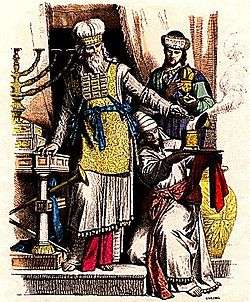Priestly golden head plate
| Part of a series of articles on |
| Priesthood in Judaism |
|---|
| |
|
Kohen · Recognition of priestly descent Priestly covenant |
|
Aaron · Eleazar · Phinehas · Eli · Ahimelech · Abiathar (First Temple) · Zadok · Shallum · Hilkiah · Jehoiada (Second Temple) Joshua the High Priest Simeon the Just Yishmael Ben Elisha Yehoshua ben Gamla Pinchus Ben Shmuel |
|
The ten gifts given in the Temple 1. Sin offering · 2. Guilt offering 3. Communal peace offering 4. Fowl sin offering · 5. Leftovers from the suspensive guilt offering 6. Oil from the offering for the leper 7. Bread from First Fruits · 8. Showbread 9. Leftovers of the meal offering 10. Leftovers of the First Sheaf.
15. Heave offering 16. Heave offering of the Levite's tithe 17. Dough offering 18. First shearing of the sheep 19. Shoulder, cheeks and maw 20. Coins for redemption of the first born son · 21. Redemption of a donkey · 22. Dedication of property to a priest · 23. Field not redeemed in a Jubilee year · 24. The property of the foreigner with no heir. |

The priestly crown or frontlet (צִיץ ṣîṣ/tsiyts) was the golden plate or tiara worn by the Jewish High Priest on his mitre or turban whenever he would minister in the Tabernacle or the Temple in Jerusalem.[1]
Etymology
The Hebrew noun tziytz (צִיץ) usually means "flower" or "blossom." as in "All flesh is grass and all the goodliness thereof is as the flower (tziytz) of the field." The term is used not just for the tiara of the priest, but also for flowers carved on the fittings of Solomon's Temple (1 Kings 6:35). The Greek Septuagint renders the word in Exodus 28:36 and elsewhere petalos (πέταλος), "blossom," from which the English "petal" derives.
Hebrew Bible
The commandment regarding the crown is found in Exodus 28:36-38:
[36] And thou shalt make a plate of pure gold, and engrave upon it, like the engravings of a signet: HOLY TO THE LORD. [37] And thou shalt put it on a thread of blue, and it shall be upon the mitre; upon the forefront of the mitre it shall be. [38] And it shall be upon Aaron's forehead, and Aaron shall bear the iniquity committed in the holy things, which the children of Israel shall hallow, even in all their holy gifts; and it shall be always upon his forehead, that they may be accepted before the LORD.
The Tzitz was a small rectangular plate of solid gold, engraved in Hebrew letters with "HOLINESS TO THE LORD," and having holes drilled in each of the four corners through which blue cords were threaded (Exodus 39:31) which held the tiara onto the High Priest's priestly turban. Traditionally, it is understood that one set of cords went around the High priest's head at the base of the tiara, and the other went over the forehead, all meeting at the back of the head to hold the tiara in place.
Exodus 39:30 refers to the tziytz as the "holy crown".
According to the Talmud, the wearing of the golden frontlet atoned for the sin of arrogance on the part of the Children of Israel (B.Zevachim 88b).
See also
- Tetzaveh, 20th weekly Torah portion (parshah)
- Priestly undergarments
- Priestly tunic
- Priestly sash
- Priestly turban
- Priestly robe (Judaism)
- Ephod
- Priestly breastplate
References
- ↑ Michael Chyutin The New Jerusalem scroll from Qumran: a comprehensive reconstruction 1997 Page 49 -"The holy diadem also appears in the dress of the High Priest (Exod. 39.30): 'They made the frontlet for the holy diadem of ..."
External links
- The Crown copy of the Tzitz made by The Temple Institute in Jerusalem